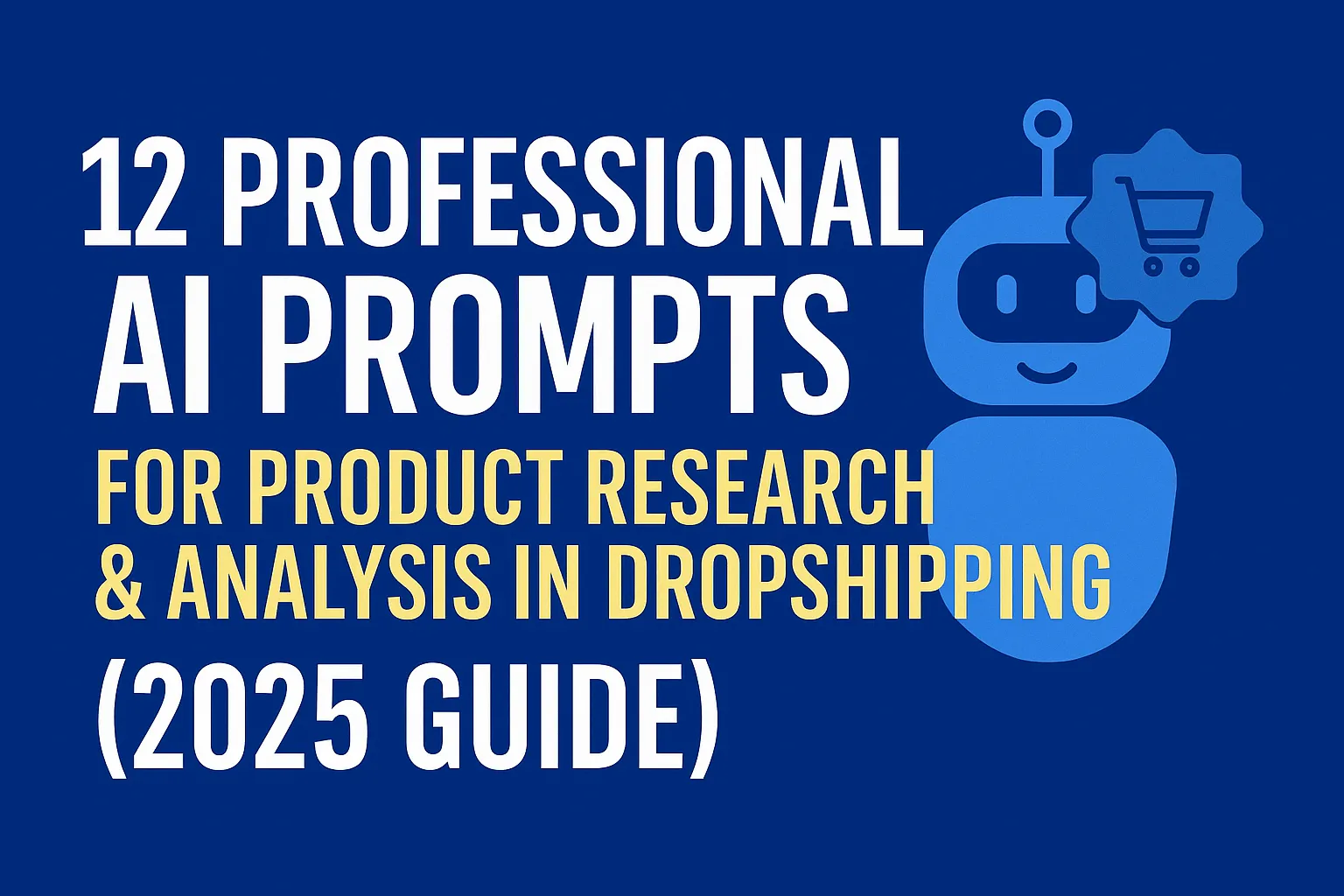Finding and validating the right product is the single most important step in building a successful dropshipping store. Most new entrepreneurs fail not because of their marketing, but because they pick the wrong products. That’s where AI-powered prompts come in: with the right instructions, ChatGPT and Gemini can act as your personal product research assistant, saving hours of manual work.
In this article, we’ll explore 12 professional AI prompts for product research and analysis. Each prompt includes a detailed description, a real-world use case, a pro tip, and a ready-to-use command you can copy straight into your AI tool.
1. Finding Winning Products
Description:
Every dropshipping journey starts with finding a product worth selling. This prompt guides AI to create a structured shortlist of low-competition, high-margin products under $30 retail price. It forces the model to think about trend triggers, audience segments, and seasonality, rather than just listing random gadgets. The output is a table that instantly gives you a research starting point.
Use Case:
You’re planning your next store launch and need a batch of product ideas filtered by profitability and scalability.
Prompt:
You are a professional product researcher for a dropshipping brand. Task: propose 12 winning product ideas under $30 retail with low competition.
Constraints: exclude trademarked items, fragile glass, and restricted lithium-battery products.
Output as a table with columns: Product | Why Now (trend trigger) | Target Audience | Est. Retail ($) | Est. COGS ($) | Est. Margin (%) | Seasonality (Low/Med/High) | Risk Notes.
Prioritize evergreen utility + strong potential for UGC virality (TikTok/Instagram).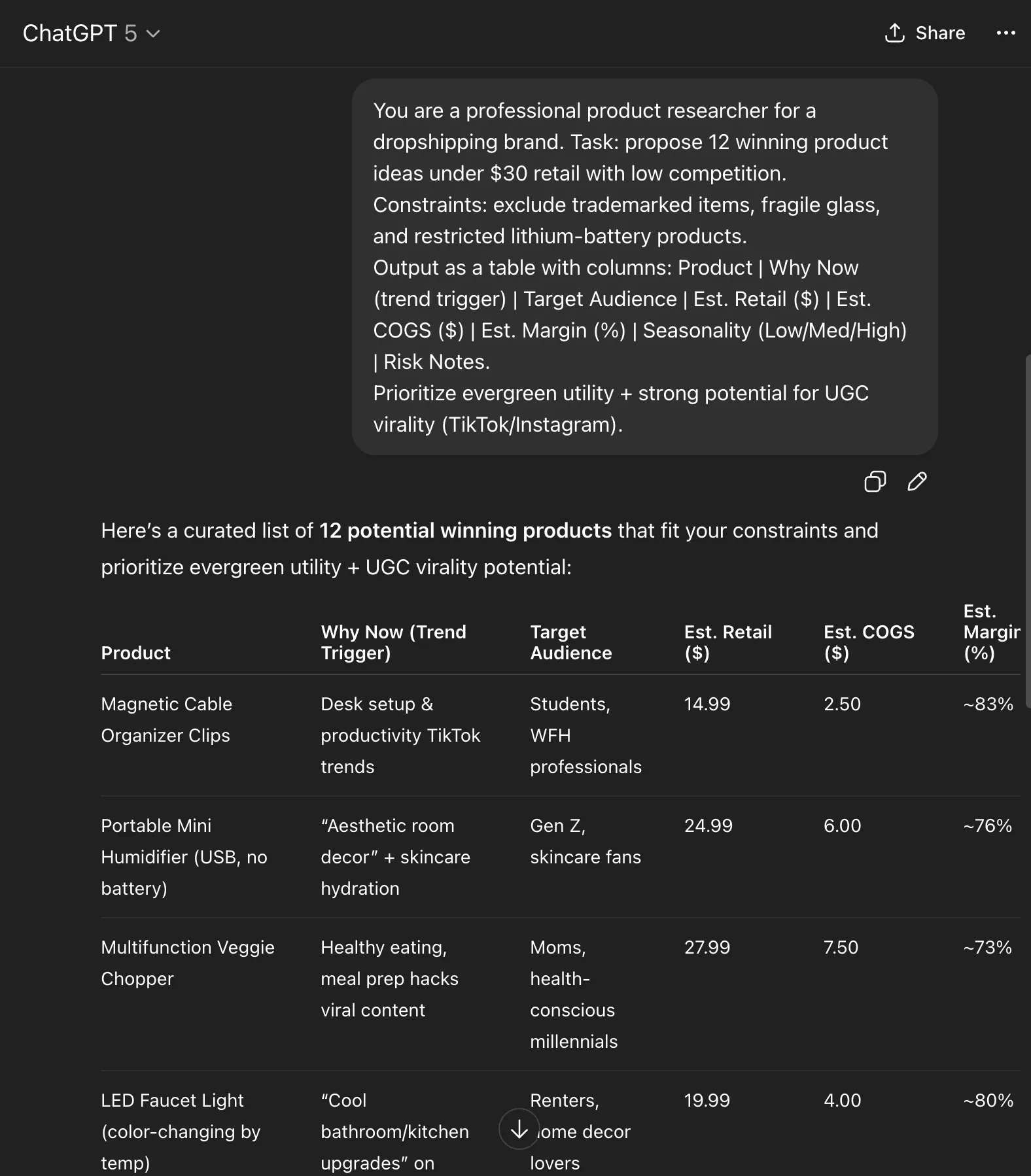
Pro Tip:
Always validate the shortlist with Google Trends and TikTok Creative Center before ordering samples.
2. Product Validation (Go/No-Go Decision)
Description:
Not every “cool” product is scalable. This prompt forces AI to simulate the work of an ecommerce analyst and break down a product from multiple angles: demand, logistics, compliance, and positioning. It even ends with a Go/No-Go recommendation plus a three-step validation plan.
Use Case:
You discovered a trending gadget on TikTok and want to know if it has long-term scalability before investing in ads.
Prompt:
Act as a senior ecommerce analyst. Analyze the product: PRODUCT_NAME.
Sections required: Market Demand (with seasonality), Unit Economics (COGS, target price, payment gateway fees, breakeven CPA), Logistics (dimensions, weight, shipping risk), Risk/Return Drivers, Compliance flags (patent/trademark), Ideal Customer Profiles (ICPs) & Use Cases, Positioning & Marketing Angles.
Finish with: Go/No-Go recommendation and a 3-step validation plan (creative test, landing page test, offer test).Pro Tip:
Ask AI for a one-page executive summary for easier decision-making with your team.
3. Unit Economics & Profit Margin
Description:
Margins are everything in dropshipping. This prompt lets AI do the math for you, showing gross/net margins, breakeven ROAS, and price sensitivity. Instead of doing manual spreadsheets, you can instantly understand whether the product can survive rising ad costs.
Use Case:
Before scaling a campaign, you want to know if your pricing structure leaves enough room for profit after ads.
Prompt:
Calculate detailed unit economics for PRODUCT_NAME.
Inputs: COGS={{COGS}}, Shipping={{SHIPPING}}, Gateway fee %={{GATEWAY_FEE}}, Platform fee %=PLATFORM_FEE, Ad spend per order={{CPA}}, Target price=PRICE.
Output a table: Gross Margin %, Net Margin %, Breakeven ROAS, Breakeven Price, Sensitivity Analysis (+/- 20% CPA).Pro Tip:
Re-run this calculation weekly — costs for ads and logistics fluctuate quickly.
4. Customer Persona Fit
Description:
Even the best products fail if targeted to the wrong people. This prompt creates detailed customer personas with demographics, psychographics, and ad messaging angles. It helps you understand not just who might buy, but also why they would.
Use Case:
You’re launching a new product but are unsure which age group or lifestyle segment to target with ads.
Prompt:
Define 3 customer personas for PRODUCT_NAME.
For each persona provide: demographics, psychographics, key pain points, motivations, buying triggers, and a recommended ad messaging angle.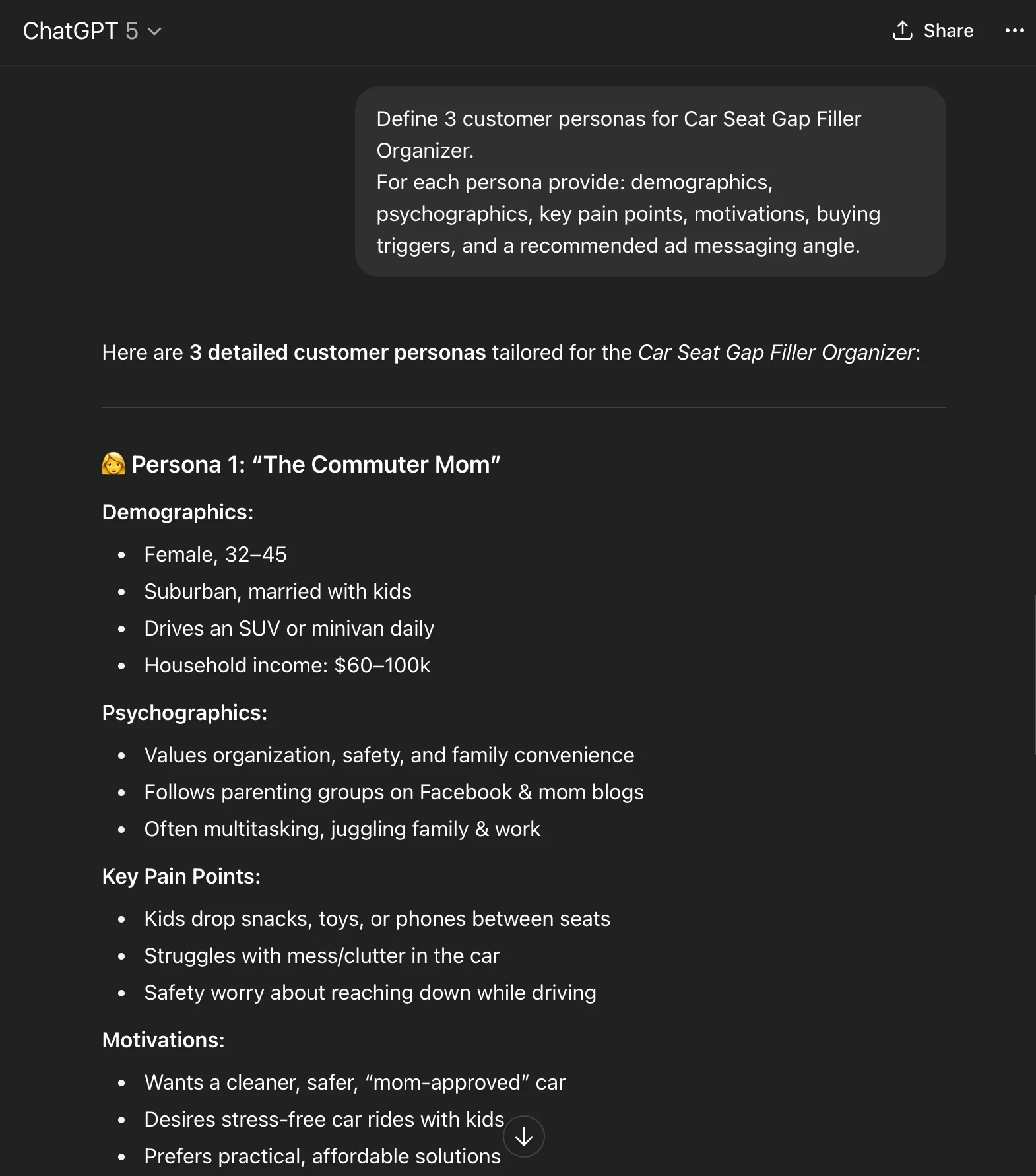
Pro Tip:
Use persona insights to adapt your creatives and landing page copy to each audience segment.
5. Trend Analysis & Seasonality
Description:
Some products peak only during certain seasons, while others are evergreen. This prompt helps you avoid launching a product that only sells for a short period unless you plan for it.
Use Case:
You’re considering adding heated blankets to your store but want to confirm if demand vanishes outside winter.
Prompt:
Analyze seasonality for PRODUCT_NAME.
Include: peak months, off-season risks, long-term trend (growing, stable, declining), and seasonal ad angle suggestions.Pro Tip:
Always cross-check AI’s insights with Google Trends or SEMrush for keyword traffic.
6. Risk & Compliance Check
Description:
Many products look attractive but come with hidden risks: shipping restrictions, safety regulations, or patent issues. This prompt helps you spot problems before you waste money on ads or inventory.
Use Case:
You want to test portable blenders but need to confirm if shipping lithium batteries could cause compliance issues.
Prompt:
Evaluate compliance, logistics, and legal risks for PRODUCT_NAME.
Check: international shipping restrictions, customs issues, trademark/patent risks, safety regulations, common return triggers.
Summarize risk level (Low/Medium/High) with reasoning.Pro Tip:
Confirm AI warnings with suppliers or legal professionals before scaling.
7. Competitive Edge Analysis
Description:
If everyone sells the same product, differentiation becomes critical. This prompt generates strategies to stand out, such as bundling, unique branding, or untapped marketing angles.
Use Case:
You want to sell LED pet collars but don’t want to blend in with hundreds of identical Shopify stores.
Prompt:
Suggest 5 differentiation strategies for PRODUCT_NAME in dropshipping.
Include: bundling opportunities, unique packaging, positioning angles, underused use cases, and creative hooks competitors miss.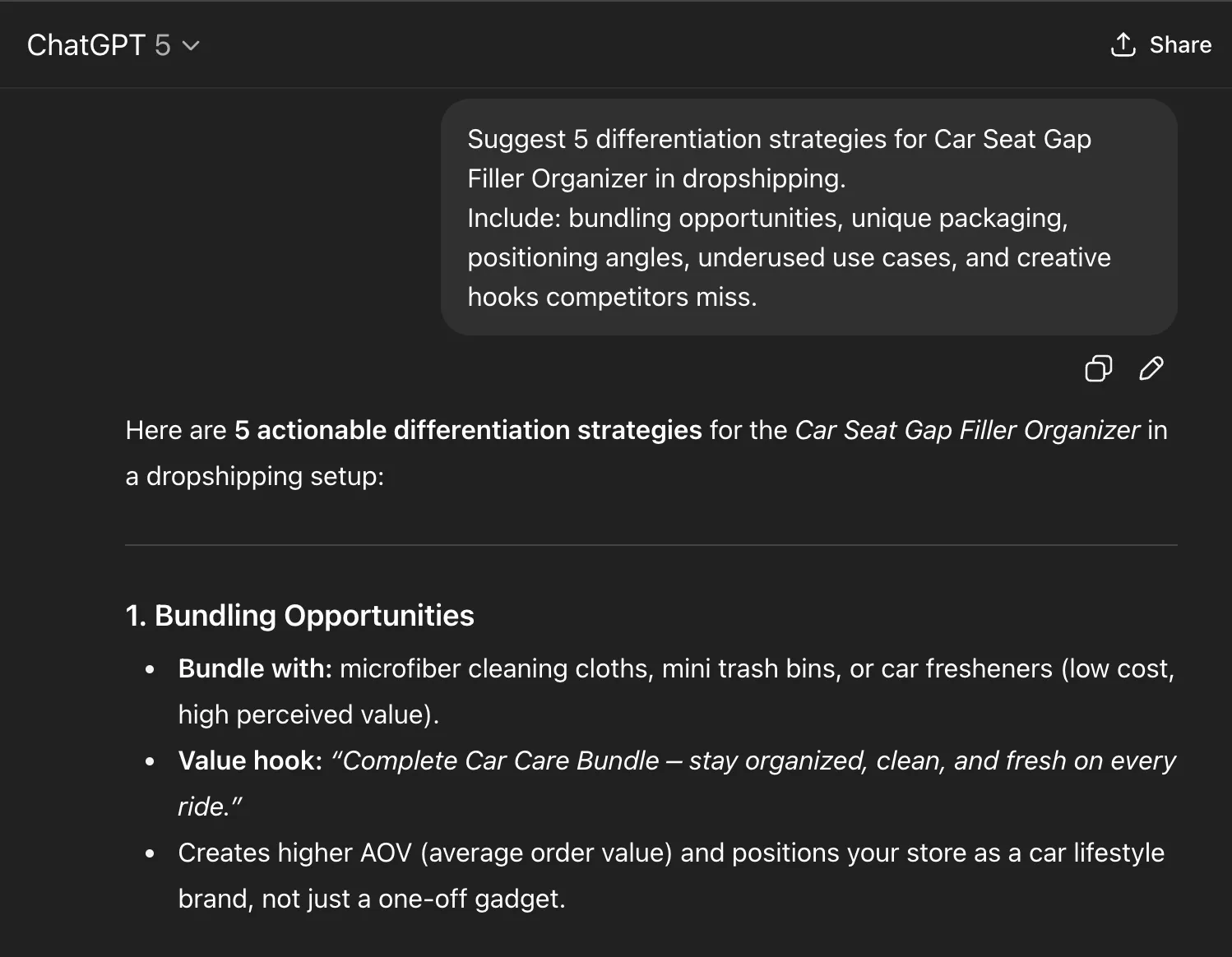
Pro Tip:
Look for opportunities to add perceived value without significantly raising costs.
8. Comparison Between Products
Description:
When torn between multiple product ideas, this prompt generates a side-by-side comparison to help you prioritize. It looks at demand, logistics, risks, and competition to recommend the strongest launch candidate.
Use Case:
You’re unsure whether to sell a posture corrector or a neck massager first.
Prompt:
Compare these products for dropshipping: PRODUCT_1, PRODUCT_2, PRODUCT_3.
Evaluate: demand, profitability, logistics complexity, compliance risks, competition level, and marketing angles.
Recommend the product with the strongest launch potential and explain why.Pro Tip:
Use comparison outputs as pitch material for partners or investors.
9. Niche Fit Check
Description:
A good product still needs to match your store’s branding. This prompt helps you avoid confusing your audience by testing whether the product belongs in your niche.
Use Case:
You run a fitness store but want to see if a portable blender would complement your catalog.
Prompt:
Check if PRODUCT_NAME fits into a {{NICHE}} store.
Assess: relevance to existing products, upsell opportunities, target audience overlap, and branding consistency.Pro Tip:
Don’t dilute your brand identity. Stick to products that strengthen your positioning.
10. Product Launch Readiness Checklist
Description:
Launching without preparation often leads to wasted ad spend. This prompt builds a detailed checklist so you can cover all the bases: supplier vetting, sample orders, creative tests, and more.
Use Case:
You’re about to launch your first “viral” TikTok product and don’t want to miss crucial steps.
Prompt:
Create a launch readiness checklist for PRODUCT_NAME.
Include: supplier verification, sample quality test, ad creative preparation, landing page setup, pricing validation, upsell funnel, and customer support macros.Pro Tip:
Turn this checklist into a project plan in Trello or Asana to manage your team.
11. Competitor Analysis
Description:
Competitors set the standard for pricing, shipping, and branding. This prompt helps you benchmark competitors and spot weaknesses to exploit.
Use Case:
You’re selling LED collars and want to know how your competitors handle pricing and delivery.
Prompt:
Find direct competitors for PRODUCT_NAME in {{COUNTRY}}. Avoid marketplaces like Amazon, Walmart
Return a table: Store | URL | Price | Reviews | Shipping (time/cost) | Differentiation notes.
Summarize: strongest competitor, price leader, brand leader. Suggest 3 counter-strategies.Pro Tip:
Use Gemini for fresher web-scraped competitor data, then organize insights with ChatGPT.
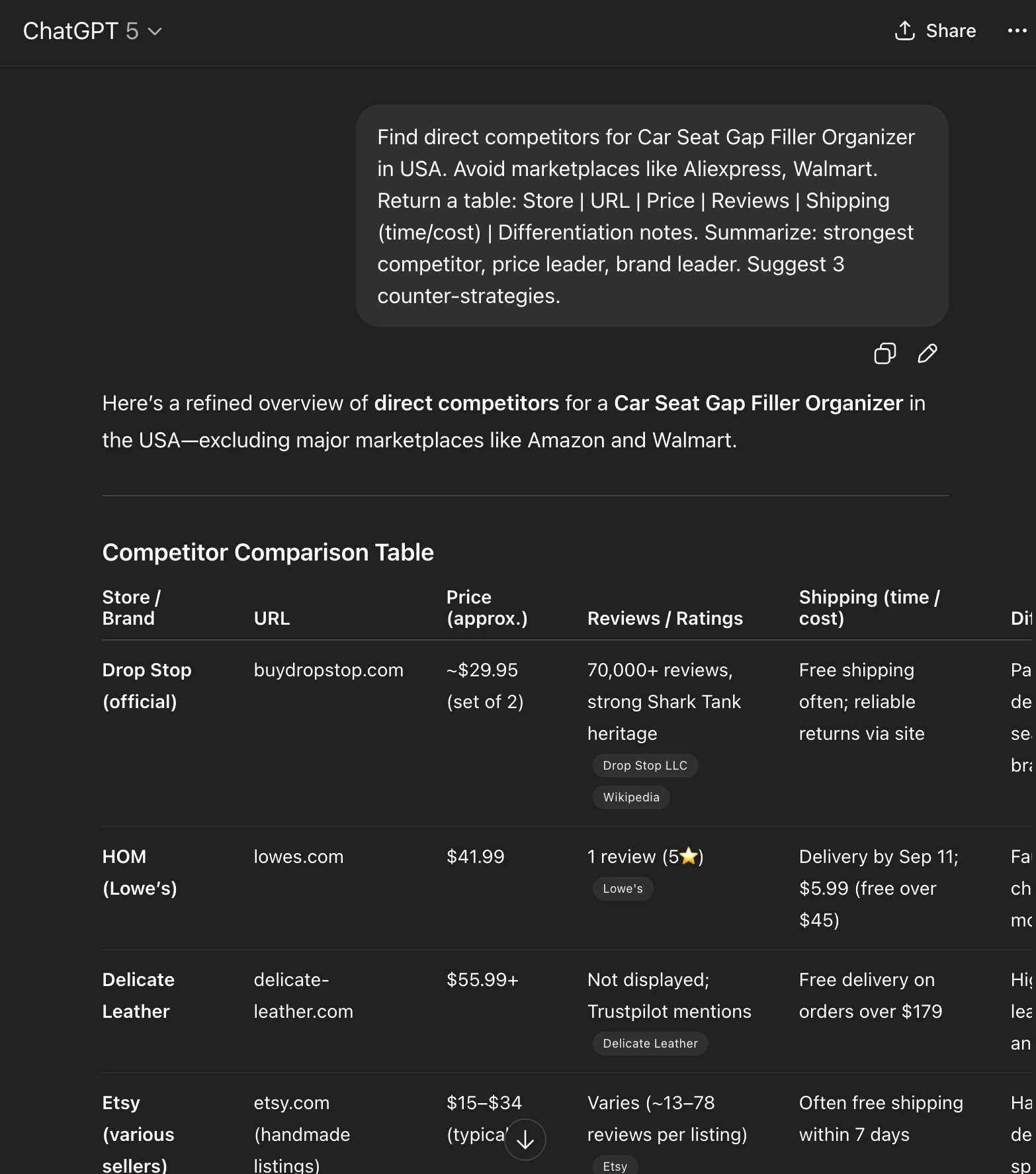
12. Market Research
Description:
Market context determines whether you’re entering a red ocean (too competitive) or a blue ocean (open opportunity). This prompt generates a niche map with top brands, channels, and whitespace opportunities.
Use Case:
You’re exploring the skincare niche and want to see if there’s still room for new players.
Prompt:
Map the niche: {{NICHE}}.
Return a table with: Top Brands (5–8) | Positioning | Price Range | Hero Product | Main Marketing Channel | Weakness.
Add: audience pain points, unmet needs, and 3 whitespace opportunities.Pro Tip:
Use these insights to niche down instead of competing head-to-head with large players.
📊 Summary Table
| Category | Prompt |
|---|---|
| Finding Winning Products | You are a professional product researcher for a dropshipping brand. Task: propose 12 winning product ideas under $30... |
| Product Validation | Act as a senior ecommerce analyst. Analyze the product: PRODUCT_NAME... |
| Unit Economics | Calculate detailed unit economics for PRODUCT_NAME... |
| Customer Persona Fit | Define 3 customer personas for PRODUCT_NAME... |
| Trend Analysis | Analyze seasonality for PRODUCT_NAME... |
| Risk & Compliance | Evaluate compliance, logistics, and legal risks for PRODUCT_NAME... |
| Competitive Edge | Suggest 5 differentiation strategies for PRODUCT_NAME... |
| Product Comparison | Compare these products for dropshipping: PRODUCT_1, PRODUCT_2, PRODUCT_3... |
| Niche Fit | Check if PRODUCT_NAME fits into a {{NICHE}} store... |
| Launch Readiness | Create a launch readiness checklist for PRODUCT_NAME... |
| Competitor Analysis | Find direct competitors for PRODUCT_NAME in {{COUNTRY}}... |
| Market Research | Map the niche: {{NICHE}}... |
✅ Conclusion
Winning in dropshipping is 80% about choosing the right product and only 20% about marketing execution.
These 12 professional AI prompts give you a framework to research, validate, and launch products with confidence.
💡 Pro Tip: Save this article or download the prompt library in Excel/Markdown format so you always have it handy when testing new ideas.
